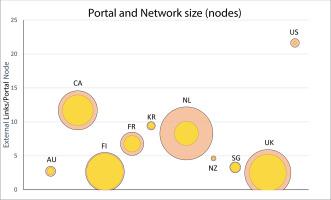Government Information Quarterly ( IF 7.8 ) Pub Date : 2021-02-27 , DOI: 10.1016/j.giq.2021.101575 Paul Henman , Timothy Graham , Lutfun Nahar Lata

|
Government webportals are central to governments' web strategy. They are designed to be nodal hubs, or gateways, for encountering government, and as such position government in the online world. Yet the designs of government webportals, particularly their location within wider web ecologies are scarcely studied. In additional to these web ecologies, this paper conceptualises webportals as being located within wider information and institutional ecologies. Methodologically, it comparatively examines the hyperlink structures of the national government webportals of the top ten e-government countries: Australia; Canada; Finland; France; Japan; Netherlands; New Zealand; Singapore; UK; and USA. Different ways governments approach this task are analyzed using webcrawls of the webportals and their neighboring webpages. Variations are considered in relation to the constitutional structures of the countries (i.e. unitary vs federated; centralized vs decentralized).
This research highlights information referral versus information repository webportal designs, the latter of which appears to arise more in unitary and city states, than federal states. The hyperlink networks also demonstrate the important structural role of commercial social media websites in half of the countries, revealing a new interactive webportal design. Despite being constructed as whole-of-government entryways, national government webportals typically fail to connect to regional and local tiers of government. The paper provides the basis for assessing the effectiveness of different portal designs and investigating how portal designs arise out of varied government institutional settings.
中文翻译:

在网络生态系统中构建“前门”:国家政府网络门户的信息治理和机构塑造
政府网络门户对于政府的网络战略至关重要。它们被设计为节点集线器或网关,用于与政府会面,并因此在网络世界中定位政府。但是,很少研究政府门户网站的设计,尤其是它们在更广泛的网络生态系统中的位置。除了这些网络生态之外,本文还将网络门户概念化为位于更广泛的信息和机构生态中。从方法上讲,它比较研究了十大电子政务国家的国家政府门户网站的超链接结构:澳大利亚;加拿大; 芬兰; 法国; 日本; 荷兰; 新西兰; 新加坡; 英国; 和美国。使用门户网站及其相邻网页的爬网分析了政府处理此任务的不同方式。
这项研究着重介绍了信息引荐与信息存储库Webportal设计之间的关系,后者在联邦和城市州似乎比联邦州更多地出现。超链接网络还展示了半数国家/地区中商业社交媒体网站的重要结构性作用,揭示了一种新的交互式网络门户设计。尽管被构建为整个政府的入口通道,但中央政府的网络门户通常无法连接到区域和地方政府层级。该文件为评估不同门户设计的有效性以及调查门户设计如何从各种政府机构环境中产生的基础提供了依据。











































 京公网安备 11010802027423号
京公网安备 11010802027423号